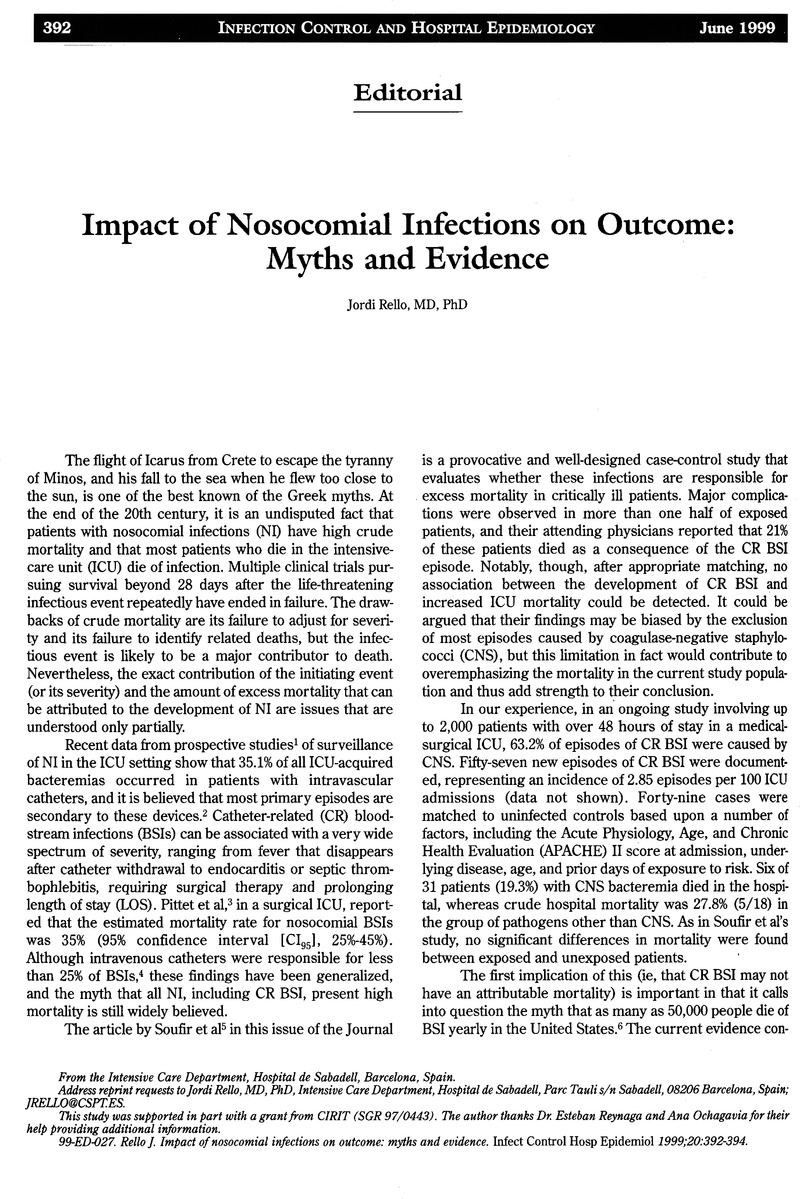Crossref Citations
This article has been cited by the following publications. This list is generated based on data provided by Crossref.
Birnbaum, David
Farr, Barry M.
and
Shapiro, David E.
2000.
Diagnostic Tests Distinguishing Good Tests From Bad and Even Ugly Ones.
Infection Control & Hospital Epidemiology,
Vol. 21,
Issue. 4,
p.
278.
Rello, Jordi
2000.
The author replies.
Infection Control & Hospital Epidemiology,
Vol. 21,
Issue. 4,
p.
249.
Macías, Alejandro E.
2000.
Impact of Nosocomial Infections on Outcome Myths and Evidence.
Infection Control & Hospital Epidemiology,
Vol. 21,
Issue. 4,
p.
248.
Lark, Rebecca L
Chenoweth, Carol
Saint, Sanjay
Zemencuk, Judith K
Lipsky, Benjamin A
and
Plorde, James J
2000.
Four year prospective evaluation of nosocomial bacteremia: epidemiology, microbiology, and patient outcome.
Diagnostic Microbiology and Infectious Disease,
Vol. 38,
Issue. 3,
p.
131.
Carlet, Jean
Timsit, Jean-Francois
Misset, Benoit
Garrouste, M.
and
S.oufir, L.
2001.
Ventilator-Associated Pneumonia.
Vol. 4,
Issue. ,
p.
165.
Farr, Barry M.
2001.
Preventing Vascular Catheter‐Related Infections: Current Controversies.
Clinical Infectious Diseases,
Vol. 33,
Issue. 10,
p.
1733.
Guardiola, J.J.
Sarmiento, X.
and
Rello, J.
2001.
Neumonía asociada a ventilación mecánica: riesgos, problemas y nuevos conceptos.
Medicina Intensiva,
Vol. 25,
Issue. 3,
p.
113.
Randolph, Adrienne G.
2002.
What underlies race and sex differences in acute respiratory distress syndrome–associated mortality?*.
Critical Care Medicine,
Vol. 30,
Issue. 8,
p.
1907.
Gudlaugsson, O.
Gillespie, S.
Lee, K.
Berg, J. V.
Hu, J.
Messer, S.
Herwaldt, L.
Pfaller, M.
and
Diekema, D.
2003.
Attributable Mortality of Nosocomial Candidemia, Revisited.
Clinical Infectious Diseases,
Vol. 37,
Issue. 9,
p.
1172.
Beekmann, S. E.
Diekema, D. J.
Chapin, K. C.
and
Doern, G. V.
2003.
Effects of Rapid Detection of Bloodstream Infections on Length of Hospitalization and Hospital Charges.
Journal of Clinical Microbiology,
Vol. 41,
Issue. 7,
p.
3119.
Shorr, Andrew F.
Humphreys, Christopher W.
and
Helman, Donald L.
2003.
New Choices for Central Venous Catheters.
Chest,
Vol. 124,
Issue. 1,
p.
275.
Rello, Jordi
and
Diaz, Emili
2003.
Pneumonia in the intensive care unit.
Critical Care Medicine,
Vol. 31,
Issue. 10,
p.
2544.
Roberts, Rebecca R.
Scott, R. Douglas
Cordell, Ralph
Solomon, Steven L.
Steele, Lynn
Kampe, Linda M.
Trick, William E.
and
Weinstein, Robert A.
2003.
The Use of Economic Modeling to Determine the Hospital Costs Associated with Nosocomial Infections.
Clinical Infectious Diseases,
Vol. 36,
Issue. 11,
p.
1424.
McConnell, Scott A.
Gubbins, Paul O.
and
Anaissie, Elias J.
2003.
Do Antimicrobial-Impregnated Central Venous Catheters Prevent Catheter-Related Bloodstream Infection?.
Clinical Infectious Diseases,
Vol. 37,
Issue. 1,
p.
65.
McConnell, S. A.
Gubbins, P. O.
and
Anaissie, E. J.
2004.
Are Antimicrobial-Impregnated Catheters Effective? Replace the Water and Grab Your Washcloth, Because We Have a Baby to Wash.
Clinical Infectious Diseases,
Vol. 39,
Issue. 12,
p.
1829.
Rello, J.
Diaz, E.
and
Rodríguez, A.
2005.
Advances in the management of pneumonia in the intensive care unit: review of current thinking.
Clinical Microbiology and Infection,
Vol. 11,
Issue. ,
p.
30.
Denholm, Justin T
Levine, Anthony
Kerridge, Ian H
Ashhurst-Smith, Chris
Ferguson, John
and
D’Este, Catherine
2005.
A microbiological survey of stethoscopes in Australian teaching hospitals: potential for nosocomial infection?.
Australian Infection Control,
Vol. 10,
Issue. 3,
p.
79.
Rello, J.
Vidaur, L.
Díaz, E.
and
Rodríguez, A.
2007.
Infectious Diseases in Critical Care.
p.
449.
Douglas Scott II, R
and
Roberts, Rebecca R
2007.
Antimicrobial Resistance: Problem Pathogens and Clinical Countermeasures.
p.
1.
Pfaller, M. A.
and
Diekema, D. J.
2007.
Epidemiology of Invasive Candidiasis: a Persistent Public Health Problem.
Clinical Microbiology Reviews,
Vol. 20,
Issue. 1,
p.
133.





